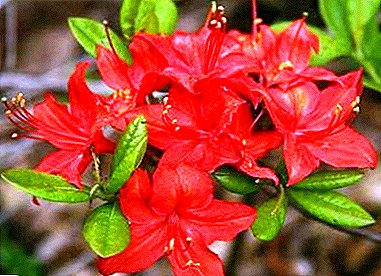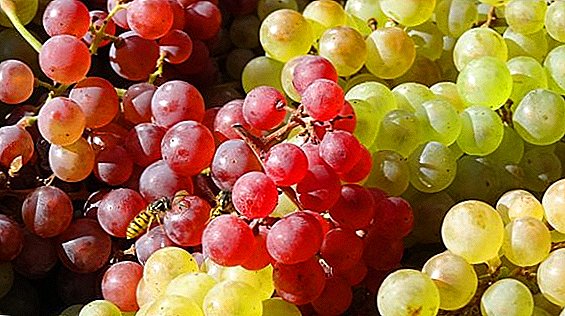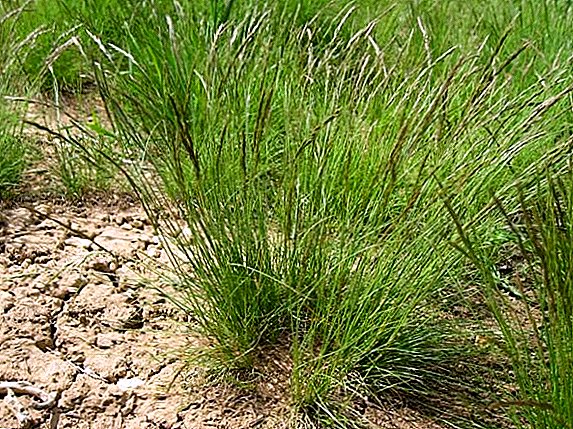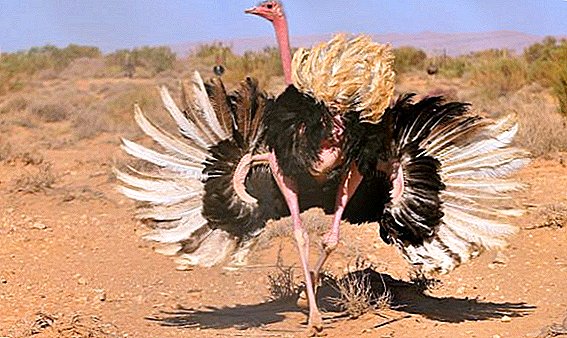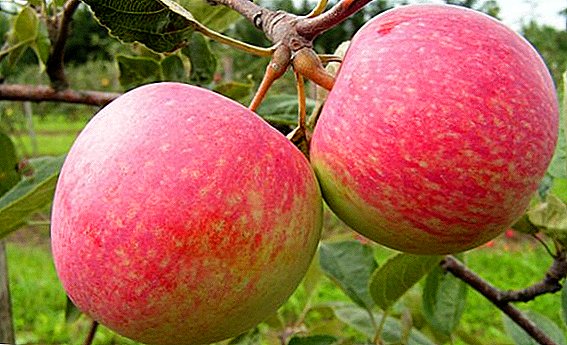 There is a huge variety of varieties of apples: winter, summer, autumn, sour, sweet. In this article, we will look at one of the most popular summer varieties — the Silver Hoof apple tree, the characteristics of the variety, the rules for planting and caring for the tree.
There is a huge variety of varieties of apples: winter, summer, autumn, sour, sweet. In this article, we will look at one of the most popular summer varieties — the Silver Hoof apple tree, the characteristics of the variety, the rules for planting and caring for the tree.
History of apple tree "Silver Hoof"
The variety of apple tree "Silver Hoof" was bred in 1988 at the Sverdlovsk Experimental Station by the breeder Kotov Leonid Andrianovich. The variety is obtained by crossing the apple trees "Snowflake" and "Rainbow". Apples are great for growing in the northern regions, as well as regions of temperate continental climate. 
Did you know? The Silver Hoof apples are considered the prototype of the "magic apples" from the fairy tales we know. They were rolled on a silver saucer in order to predict fate, see the road, cities, fields, rivers, get advice or answers to exciting questions.
Description of the characteristics of the variety
Apples of this variety are loved by many. They are grown not only in private households, but also in fruit nurseries. Let us consider why the Silver Hoof apple tree and the variety description are so popular.
The Silverhoof apple tree has many advantages:
- good yield;
- resistance to falling of fruits;
- short term ripening apples;
- small tree growth;
- compact crown;
- early variety;
- winter hardiness;
- beautiful fruits of the correct form;
- wonderful taste;
- fruits tolerate transportation well;
- apples are suitable for use fresh, and for preservation, drying, cooking compotes, wine.

Important! There are practically no drawbacks to this variety. However, with improper care fruits become small, their taste deteriorates. In addition, trees are particularly prone to scab and fruit rot.
Tree description
The tree grows of medium size. The crown is round, dense and compact at the same time, it does not grow too wide. Thanks to this, apple trees can be planted close to each other. The branches are straight, depart from the trunk almost at a right angle, are located next to each other. The bark of the trunk is a rich brown color, the shoots are slightly lighter, with a yellowish tinge. Bark branches smooth, slightly glossy.
The foliage of the apple tree is light green, matte, it is round and oval in shape, slightly pointed at the ends. The edges of the sheets with notches slightly raised upwards. Blossoms medium and large cupped inflorescences. Petals are large, round and oval. The color of flowers and buds is white. 
Fruit Description
Silver Hoof apples are very beautiful: round, regular shape, smooth with a glossy shine. The fruit color is mostly deep red, sometimes with an orange tint. Often on a bright red background, blurry patches of pale yellow, cream shades are formed. The peel is thin, has a beautiful wax coating.
The taste of apples are sweet and sour. The flesh is fine-grained, dense and very juicy. The weight of one unit varies from 70 to 90 g. The aroma of the fruit is mild. Seeds are small, round, black and brown. Apples tolerate transportation and storage.
Did you know? The Silver Hoof apple tree, due to its characteristics, is very popular in breeding, and is often used to breed new varieties that are resistant to frost, disease and pests.
Pollination of the apple tree "Silver Hoof"
Apple silver hoof has a certain feature in the cultivation. The variety is not capable of self-pollination. Therefore, pollinators must grow next to it. The best sort of apple is considered "Anis Sverdlovsk". “White filling”, “Zhigulevskoe”, “Cowberry” are quite good. You can plant other varieties.
The main rule that should guide the choice of the pollinator is that the variety should bloom and bear fruit at the same time as the Silver Hoof. The distance between the apple tree and the pollinator should not exceed one kilometer. 
How to choose apple seedlings when buying
To grow a strong, productive tree, the quality of planting material is very important. If you want to be one hundred percent confident in the "purity" of the variety and good quality of the seedling, it is best to buy in the nursery. In addition, the tree must be labeled with the name of the variety, company and its coordinates.
When choosing a tree, it is necessary to pay special attention to the condition of the roots and foliage. The root system should be well developed, branched, and the roots look alive. On the roots there should be no signs of damage, damage to the root rot, cancer and other diseases. Do not buy seedlings with weak, dry, drooping roots.
Important! When inspecting the root system, note whether the roots hold earthy lumps. If the earth does not hold onto them, then the roots are weak or painful.
You also need to inspect the sheet plate above and below. It should be dense, saturated color, without holes, plaque and other signs of disease or damage by pests.
The leaves of the apple tree "Silver Hoof" are dull, light green. The presence of glossy shine, white bloom, black dots indicates the defeat of a seedling with fungal diseases or aphids. Be sure to look under the foliage - there can hide aphid. Do not buy seedlings with dry, twisted, drooping foliage. 
Rules for planting apple seedlings "Silver hoof" on the site
If you provide the Silver Hoof to the apple tree with the proper fit and care, the first harvest can be expected by the fourth year. And in the fifth or sixth year to collect a full-fledged large crop of large, beautiful and delicious apples. Therefore, the choice of time and place for planting and the observance of the rules for planting seedlings should be approached responsibly.
Landing dates and site selection
Apple seedlings can be planted both in spring and autumn. In the spring, the best time is at the end of April, in the fall - from the end of September to mid-October. However, most gardeners consider the most favorable autumn planting.
Place for landing should be well lit. It is desirable that the groundwater level was as deep as possible, so that the root system of the tree is not affected. The variety is not particularly demanding on the soil, but it is best if it is loose and well drained. This will ensure the oxygen permeability to the root system, prevent stagnation of excess water and the appearance of fungal diseases. Apple tree does not like too sour soil.
Did you know? To make the soil more loose, garden soil, which will sprinkle the roots, can be mixed with sawdust or peat.
It is recommended to plant a seedling immediately after purchase, as a last resort - in a couple of days. 
Stepwise landing process
Now consider how to plant an apple tree, in full detail. First you need to dig a hole. Its width should allow to place the seedling with straightened roots without difficulty, and the depth along the root neck of the tree.
It is recommended to place a layer of a mixture of 4 kg of humus, 40 g of superphosphate, 20 g of potassium and urea at the bottom of the pit. The mixture on top is covered with a layer of earth so that the root system does not get burned. The seedling is placed in the middle of the pit and sprinkled with soil on the root neck. Then the soil is watered.
To the seedling was not affected by the wind, it is recommended to install a peg-support next to it and tie a tree to it.
Important! In case of drying of the roots, it is recommended to slightly soak them with water. Damaged and too long roots should be cut off, sprinkling black coal tablets with powder.
Rules of seasonal care for the apple trees "Silver Hoof"
 The apple tree The silver hoof with good care and timely pruning gives a bountiful harvest of large apples. Caring for a tree is simple, but if you violate its basic rules, the fruits will be small and not very tasty, and the seedling will become more susceptible to disease.
The apple tree The silver hoof with good care and timely pruning gives a bountiful harvest of large apples. Caring for a tree is simple, but if you violate its basic rules, the fruits will be small and not very tasty, and the seedling will become more susceptible to disease.
All care is a few basic actions:
- timely watering;
- treatment of diseases and pests;
- loosening the soil and removing weeds;
- periodic fertilizer;
- pruning branches.
Pest and disease treatment
The Silverhoof apple tree is characterized by an average level of resistance to fungal diseases and pests. This variety is most susceptible to diseases such as scab and fruit rot.
Scab most often it affects the tree due to excessive moisture or acidity of the soil, too thick crown, excessive application of nitrogen fertilizers. The disease is manifested by the formation of brown-green spots on the leaves, buds and ovaries. When identifying the first signs of illness, the tree should be sprayed with fungicides. 
To prevent scab, it is recommended to regularly loosen the soil around the tree, trim the crown in time and sprinkle the soil around the trunk with wood ash. It is also useful in the fall to spray the tree with a 7% urea solution.
Did you know? The most effective method of dealing with scab on young trees is their treatment in early spring with 3% Bordeaux liquid.
If the scab does not move away, in the spring, when the foliage begins to bloom, the apple tree should be sprayed with the “Skor” solution (1 ampoule per 10 liters of water). After the apple tree has faded, it needs to be treated with a 1% solution of copper sulfate.
Fruit Rot can overtake the apple tree due to excessive soil moisture, crown thickening, damage to fruits by birds or hail. Brown spots are formed on the affected fruits, which with the development of the disease affect the entire fetus. In addition, leaves and branches of the affected tree begin to rot. 
When identifying signs of fruit rot, the affected fruits, leaves and branches should be removed, and the tree treated with 1% copper sulfate or antifungal drugs "Kartotsid", "HOM".
Against aphids, an apple tree can be effectively sprayed with the means "Fitoverm" in May. From strollers saves treatment "Karbofos", which is carried out immediately after the flowering of the tree. Against the caterpillars, "Biotoxibacillin" is effective, they are sprayed after the apple tree has faded.
Watering trees
Apple tree does not like too moist soil. The first abundant watering necessarily carried out after planting the seedling. Then the tree is watered only during periods of prolonged drought. In more than the usual amount of moisture the plant needs during flowering and fruiting. After the harvest is collected, watering is reduced to a minimum.
Fertilization
The first fertilization is carried out when planting the seedling. Then feeding is recommended for the second year of growth of the tree. In April, one of these fertilizers is applied to the soil:
- 0, 5 kg of urea;
- 30 g of ammonium nitrate;
- humus bucket.
Important! Fertilizers should not be applied near the trunk, but along the crown perimeter.

During flowering, apple trees are fed with a mixture of 100 g of superphosphate and 60 g of potassium. In summer and autumn it is useful to feed apples with phosphate and potash fertilizers. This will improve their resistance to winter frost. You need to be very careful when applying nitrogen fertilizers under young trees. The mixture should be well diluted with water so as not to burn the roots. Young seedlings especially need abundant feedings.
Soil mulching
Mulching involves placing on the surface of the treated soil sawdust, bark, straw, dry foliage. Mulching retains moisture in the soil, prevents the growth of weeds, plant root root damage, protects the roots from overheating or freezing.
The soil is mulched in spring and autumn after weeds have been removed, the soil has been loosened and fertilizers applied. Mulch is laid out from the trunk to the width of the crown in a layer of 10 cm. Mulch soil is watered less often, but more abundant.
Dry leaves must be mulched very carefully. Make sure that they are not infected. If in doubt, it is recommended to treat the mulch with urea.
Pruning
The branches are pruned in early spring or autumn, after the tree has completely otlodoneos and throw off the foliage. First you need to remove all the affected, damaged branches. To improve fruiting, it is recommended to prune apple trees according to the bush pattern: leave a few main shoots and side branches. The crown in the form of a bush will contribute to the penetration of the required amount of sunlight and good ventilation. 
In order not to damage the tree, you need to know how to prune an apple tree. Cut at an angle from the trunk or the main branches. If the process is carried out in the spring, you need to be very careful; pruning is possible only before the period of active movement of the juice along the stem. Young trees should be pruned more often and more abundantly. The most optimal form for them is sparse crown and several tiers of branches.
Did you know? If you lubricate the places of cuts of the main branches with mastic for gardening, it will prevent the outflow of juice and useful substances from the branches. Such a tree will recover from trimming much faster.
Harvesting and storage of crops
 Apples begin to ripen in mid-late August, depending on climatic conditions. If you overdo them on the branches, the fruit is poured much, but their taste deteriorates. With proper storage, apples retain taste for about 2-3 months.
Apples begin to ripen in mid-late August, depending on climatic conditions. If you overdo them on the branches, the fruit is poured much, but their taste deteriorates. With proper storage, apples retain taste for about 2-3 months.
The most optimal storage conditions:
- 90-95% humidity;
- temperature from 0 to -2 ° C;
- the use of wooden containers;
- Store in a well-ventilated area.



